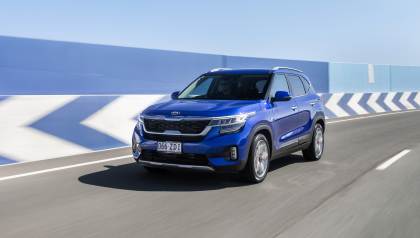You won’t be able to pick the 2021 Honda HR-V from a 2020 or 2019 model from the outside. Nope, it still looks identical to the facelifted model launched late in 2018.
But there has been an important change to Honda’s small SUV. It’s on the inside. And it involves the touch screen. We’ll get to it soon, but first we need to consider the market in which the HR-V competes.
It’s up against rivals like the VW T-Cross - you can see how it fared in our comparison here - and it also competes with the all-new Nissan Juke, still-very-new Kia Seltos and the just-updated Skoda Karoq. All of those cars are either new-generation models, or within a few years of their local launches.
The Honda HR-V? Well, it first debuted here way back in 2014. So it’s old. Like, really old for a small SUV. The only cars older than it in its segment are the Nissan Qashqai and Mitsubishi ASX.
That means it is starting to feel its age. Has this latest update - which adds a little bit of youthful tech to the package - given it the Botox it needs right now? Read on to find out.
Honda HR-V 2020: RS
| Engine Type | Inline 4, 1.8L |
|---|---|
| Fuel Type | Unleaded Petrol |
| Fuel Efficiency | 6.7L/100km (combined) |
| Seating | 5 |
| Price From | $23,870 - $29,480 |
| Safety Rating |
|
Does it represent good value for the price? What features does it come with?
7 / 10
Prices are up across the HR-V range for 2021 - every model is at least $500 more expensive than the 2020 model it replaces.
.jpg)
There are still four variants to choose from: VTi ($25,490 MSRP - up $500); VTi-S ($29,140 MSRP - up $1150); RS ($32,490 MSRP - up $500); VTi-LX ($35,740 MSRP - up $1150).
You can read our earlier coverage if you want a detailed list of standard equipment across the Honda HR-V line-up, but the RS is the variant this review is focusing on, so let’s look at what you get for your money.
The RS has a unique styling pack with 18-inch alloy wheels (more on that below), plus it has standard LED headlights with LED daytime running lights, LED fog lights, LED tail-lights, keyless entry with push-button start, rear privacy glass, RS badges, auto rain sensing wipers and auto headlights.
The interior scores leather seat trim with manually adjustable front seats, front seat heating, single-zone climate control, leather steering wheel with paddle shifters, black headlining, sports pedals and - only in the RS - variable gear ratio steering. More on that in the driving section.
.jpg)
The big change in the 2021 HR-V is the 7.0-inch touchscreen media system, which is the same size as before, but not offers owners smartphone mirroring tech. That means you get Apple CarPlay and Android Auto, though the existing sat nav has been dumped. And in the VTi-S, RS and VTi-LX you still get Honda’s LaneWatch blind spot camera system. Read more about the safety inclusions and shortfalls in the section below.
Do colours (or colors) matter to you? Sadly we don’t get the nice green, purple and brown options that other markets have. And the good news about paint choices is that no colour will cost you any extra money.
There are quite a few to choose, including: Passion Red Pearlescent, Brilliant Sporty Blue Metallic, Taffeta White (only on VTi), Platinum White Pearlescent, Lunar Silver Metallic (as seen here), Modern Steel Metallic grey, and Crystal Black Metallic (not available on VTi). Buying the RS model? You can choose Phoenix Orange Pearlescent, but that hue isn’t available on any other grade.
Is there anything interesting about its design?
8 / 10
The Honda HR-V is the most cleverly packaged small SUV you can buy. It’s amazing to consider how much space the engineers have managed to eek out of a car of this size.
.jpg)
The dimensions are 4360mm long (on a 2610mm wheelbase), 1790mm wide and 1605mm tall, which makes it sit at the upper end of the “Small SUV” segment alongside the likes of the Qashqai and ASX. But it beats those two, and plenty more, when it comes to cabin space. We’ll get to more detail in the next section, but just know this - it packs more in than you’d expect.
The exterior of the HR-V? Well, it’s starting to look a bit dated, and it’s no wonder after seven years on sale.
.jpg)
The game has certainly moved quickly in more recent times, with some rivals offering more outlandish and characterful designs - the Toyota C-HR and upcoming Yaris Cross, for instance, not to mention the likes of the Hyundai Kona and the all-new Nissan Juke.
But if you’re sold on the HR-V and the RS tickles your curiosity bone, that’s because it looks a bit different to the rest of the range.
The RS gets a body kit with piano black highlights around the wheel arches, lower front and rear bumpers, side skirts and mirror caps. The section below the ‘black chrome’ grille is a honeycomb texture, plus it has dark chrome front door handles, a dark chrome rear numberplate garnish, and it rides on the biggest wheels in the HR-V pack - 18-inch rims with Dunlop Enasave 225/50/18 rubber.
How practical is the space inside?
9 / 10
As mentioned above, the HR-V is a pragmatist’s car. If you’re the sort of person who digs the idea of a tiny house, you’re going to love the HR-V.
That’s because it packages a lot of smarts into its little body. I’m referring to, mainly, the 60:40 rear Magic Seats. They are almost like witchcraft, allowing you to lift up the seat bases in that split or altogether, while the seat backrests can also be lowered completely flat, allowing a massive storage space if you have longer items to cart with you.
I’m talking about 1462 litres (VDA) when the rear seats are folded down, or a still excellent-for-the-class 437L (VDA) with the rear seats in the upright, most reclined position. That figure is to the parcel shelf level, though the standard cargo cover is actually a folding mesh divider. You can option an accessory hard tonneau cover for the cargo area if you need it.
The boot easily fit all three CarsGuide suitcases (124L, 95L and 36L) with the seats in place, and there was actually room to spare. Speaking of spare, under the boot floor is a space saver spare wheel.
Really, the HR-V’s boot and back seat is why you buy this car. It’s superbly practical and really spacious as well. In the back row, with the driver’s seat set for my position (I’m 182cm or 6’0”), I had enough space to sit for hours. There’s ample knee room, toe room and shoulder space, and while headroom is good those who are taller will need to watch their head getting in or out of the car, as the roofline rakes down quite a bit.
Rear amenities comprise dual map pockets and there are door pockets which are a weird shape, making it hard to fit a bottle in. There is no centre armrest or cup holders, but there’s a bottle holder in front of the middle rear seat, which is also where you’ll find a 12-volt outlet - but sadly, no USB ports, as many competitors now offer.
The materials are really nice, with soft finishes on the doors and padded elbow sections - all of which make the rear seat of the HR-V feel a bit more special than most rivals.
Up front the design of the dash has stood the test of time okay, though even with the new media screen it isn’t as modern as many rivals. The screen itself is positioned at a bit of a strange angle, which meant that driving at night saw a reflection on the windscreen up near the rearview mirror.
.jpg)
The screen itself isn’t the best quality, either. There’s a weird fuzziness to the display, and it’s not as high resolution as, say, a VW T-Cross’s screen. It looks a bit blurry, as you might be able to see from the images.
The menus on-screen are reasonably easy to learn, but annoyingly there is no volume knob for quick adjustments. Further, you can’t change the audio settings (bass, treble, EQ etc) when you have a smartphone connected via USB. It has to be done when you’re not plugged in, which means you might set the wrong parameters for what you end up listening to.
.jpg)
That’s annoying. And you know what else was annoying? That our test car's screen didn't flick in to Android Auto mode when we connected an Android phone. We tried multiple times, yet couldn't get it to work.
So while the addition of the new screen does bring the HR-V up to date in terms of phone mirroring tech, you could actually probably do better by choosing an aftermarket head unit and having it installed. If you bought a pre-owned HR-V and did that, you’d save some big cash, too.
Otherwise the cabin is pretty good up front, with door pockets suitable for bottle holders, central multilevel cup holders (that can be turned into bottle holders if you need), plus a small covered centre console bin. There’s no space in front of the gear selector for your phone or wallet, but there’s a shelf below the selector - which is a bit out of sight and out of mind - that would be suitable for a handbag.
.jpg)
That’s also where the USB ports are - one for the screen (thankfully, because the old screen had a USB port that made for a messy cable situation), the other for recharging devices. There’s a 12-volt outlet there too.
The pixelated monochrome digital driver’s display doesn’t have a digital speedo, and it’s just another element that dates the cabin of the HR-V. But if you can overlook those little things, it’s a very practical car.
What are the key stats for the engine and transmission?
6 / 10
No news here. It’s still the same 1.8-litre four-cylinder petrol engine with 105kW of power (at 6500rpm) and 172Nm of torque (at 4300rpm). Those figures are low for the class.
The motor pairs to a continuously variable transmission (CVT) automatic, and it’s front-wheel drive (FWD/2WD). Other markets get a six-speed manual transmission, and there are all-wheel drive (AWD) models out there in the world, but they’ve never been available here.
.jpg)
Nor has a hybrid model, despite it being offered around the globe. There’s no plug-in hybrid or electric model in this generation, though.
How much fuel does it consume?
8 / 10
The HR-V line-up’s fuel usage ranges between 6.6L/100km and 6.9L/100km depending on the variant. The official combined cycle fuel consumption for the Honda HR-V RS model is pegged at 6.7 litres per 100 kilometres.
On test, I saw a return of 7.4L/100km, which is consistent with the long-term Honda HR-V RS I had for six months. That’s decent.
.jpg)
The fuel tank capacity is 50 litres, which is pretty large for a car of this size. Theoretical range for a full tank is 675km based on my real-world fuel consumption experience.
What's it like to drive?
7 / 10
So you’re buying the RS model as it’s supposed to be more fun. It looks the part, and the RS badges and 18-inch wheels sell the idea of it being a bit more of a hot model than the rest of the HR-V range.
Sadly, for the most part it’s a case of smoke and mirrors.
The 1.8-litre engine and CVT aren’t the most enjoyable pairing, and the powertrain - while offering enough grunt for a car of this size, which weighs in at a relatively light 1294kg in RS spec - is really quite dull.
You can put the transmission into ‘S’ for ‘sport’ mode, and that’ll mean it will rev a little harder and hold its momentum at higher revs. But really, it’s not that sporty. You could also take matters into your own hands by using the paddle shifters, but even that’s not a ‘real’ gear change experience as the CVT can slur between ‘shifts’.
.jpg)
At urban speeds around town, the powertrain is fine. Just fine - not fun. On the open road it remains the same. There’s enough power to overtake slower moving traffic, though it’s hardly enticing you to push the limits.
The steering, though. It’s the funnest part of the recipe. Honda has fitted the HR-V RS with a variable ratio steering rack, which just makes it react a bit quicker and feel more darty when you change direction.
The steering itself isn’t overly involving in terms of feel through the wheel, but it is quick to react and reasonably good to push through corners. There’s reasonably good grip from the Dunlop tyres, and it’s a pretty well balanced car in the bends, too.
The suspension is unchanged between the ‘regular’ HR-Vs and the RS model, though those big alloy wheels and low profile tyres can make the ride feel a little bit jiggly and bumpy, particularly at the front axle over bumps.
When the surface is smooth below, the ride is perfectly acceptable. It’s just when you hit a harsh section or a sharp edge that things get a bit unpleasant. And there’s noticeable road noise intrusion on coarse chip sections of road as well - not deafening, but certainly not as hushed as when on concrete freeways.
Warranty & Safety Rating
What safety equipment is fitted? What safety rating?
6 / 10
The Honda HR-V was awarded the maximum five-star ANCAP safety rating back in 2015, but times have changed fairly dramatically since then in terms of expectations around safety technology in new cars.
As such, the HR-V is falling short of its rivals in many ways. Admittedly it has a low-speed auto emergency braking (AEB) system that works between 5km/h and 32km/h, but there’s no pedestrian detection or cyclist detection as part of the AEB system.
There is also no lane keeping assistance, no traditional blind spot monitoring (models from VTi-S up have Honda’s proprietary LaneWatch camera system for the passenger side), no rear cross-traffic alert, no rear AEB, and no adaptive cruise control.
.jpg)
On the top-spec VTi-LX you do get auto high beam headlights, lane departure warning and forward collision warning, but it’s beyond me why Honda hasn’t rolled that tech out on other variants to at least give the HR-V a chance in the lower grades.
All HR-Vs have a reversing camera, and VTi-S and up have rear parking sensors, too. The VTi-LX adds front parking sensors as well.
Where is the Honda HR-V built? It’s made in Thailand.
What does it cost to own? What warranty is offered?
7 / 10
The Honda HR-V has a five-year/unlimited kilometre warranty plan, which is paired to a 10-year capped price servicing plan.
The service intervals are set at 12 months/10,000km - so if you do a lot of driving you might have to end up getting the car serviced more than once a year. At least the service costs are low, pegged at an average of $310 per year over the first three years.
Unlike some rivals, Honda doesn’t yet offer a pre-purchase service plan - so you can’t simply roll in the ownership costs to your monthly car payment.
The brand also doesn’t offer free roadside assistance, as many others do. You can get it as part of the brand’s Premium Roadside Assist option that is included in the added-cost extended warranty plan (seven years/unlimited mileage).
Verdict
If you’re after a small SUV that packs a lot of space in, then the Honda HR-V is the best option on the market. It can’t be beaten for overall practicality in a small footprint.
But it’s really starting to fall behind its rivals for safety tech, engine goodness and it’s starting to feel old inside, too. Yes, the new screen has given it a welcome shot in the arm, but the HR-V needs more than a facelift to keep it relevant against the seemingly unending list of impressive newcomers in this class.
Pricing Guides



.jpg)
.jpg)
.jpg)
.jpg)
.jpg)
.jpg)
.jpg)
.jpg)
.jpg)
.jpg)
.jpg)
.jpg)
.jpg)
.jpg)







.png)








.jpg)
.jpeg)
.jpg)

.jpg)




.jpg)


Comments